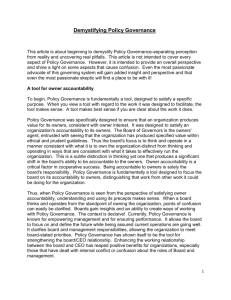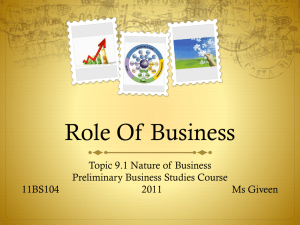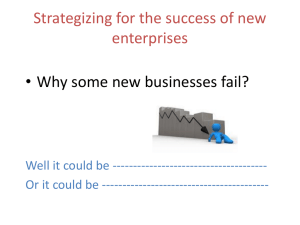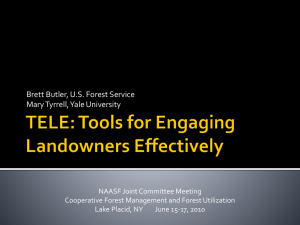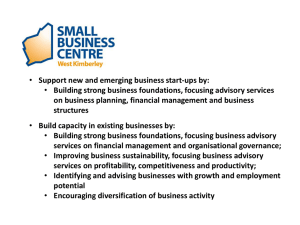Speaking Owner-ese - International Policy Governance Association
advertisement
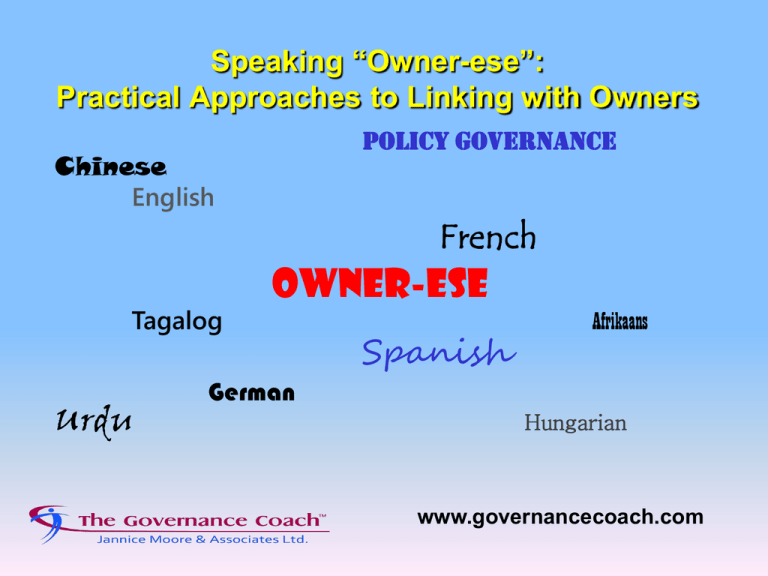
Speaking “Owner-ese”: Practical Approaches to Linking with Owners Policy Governance Chinese English French Tagalog Urdu OWNER-ESE Spanish Afrikaans German Hungarian www.governancecoach.com Clearly Identify Owners The people on whose behalf the board governs and determines what benefits the organization should produce, who those benefits are for, and how much they are worth Equivalent of “shareholders” in a forprofit organization NOT the same as “stakeholders” Know the Purpose of Ownership Linkage Intentional and constructive dialogue and deliberation between owners and board members primarily around the organization’s Ends Not the same as “Public Relations” Critical part of the information used to make Ends decisions Select a Representative Sample of Owners “Segment” owners into bite-size pieces that will help you identify the diversity of opinion among owners E.g., geography, age, education, socioeconomic status Determine The Language of Engagement Do the owners know they are owners? What “language” do they speak? Is it necessary to provide some basic education before asking for input? What’s The Owners’ Language? Chinese English Policy Governance Hungarian French Tagalog Urdu OWNER-ESE Spanish German Quechua Afrikaans “Translation” Approaches Do owners understand the language of Policy Governance? [Usually not!] Is it necessary to teach them that language? They need to understand why you are asking the questions If Policy Governance is new to your organization, you may need to explain why you are using it Key Areas to Translate Basic idea of Policy Governance – that board acts on behalf of owners, sets direction, holds management accountable, doesn’t handle day to day operations Concept of ownership linkage and why board is doing it (difference from customer issues) Board wants owners’ input to help create the future Board is not asking about individual “customer” issues Ask Questions That Generate Owner Responses Get them into “owner” mindset “as a member of your community . . .” “in your industry . . .” “thinking about other people your age . . .” Not, “what do YOU think/want “Individual” mindset will likely yield “customer” information instead of “owner” information Ask Questions About the Right Things Do not ask for input about operational issues already delegated to the CEO Input primarily about Ends issues Ask “what” and “why” questions, rather than “how” questions Examples of “What” Questions What are the priority needs in your community/industry that are not being met? If there could be only one need, that if met, could immediately assist your industry/community, what would that be? What difference should this organization make within your community/profession/industry? Some Specific “What” Examples What will be the things graduates need to know to be prepared for the “real world” of employment? [education] What are the major financial challenges members will face in the next 5 years [credit union] Think about your needs and the needs of other senior citizens that you know, those who are well and unwell. What concerns do seniors have about their ability to stay independent and in their homes? [health/social services] Examples of “Why” Questions Do people [your age/in your community] think the role of this organization should change? Why or why not? Look at the following list of outcomes that xx organization might offer: [list high level Ends] Which one seems most important? Why? Which one seems least important? Why? Which seems unlikely that a [type of organization] would offer? What is missing? Help Them Think “Future” Looking ahead 3 years from now, what results would have happened for the people we serve for you to say, “I’m really happy with the progress that the organization has made?” Pretend it is 3 years from now and you are looking back. What results would have happened for the people we serve for you to say, “I’m satisfied with the contribution that the organization has made?” Choose the Most Appropriate Methods • Interviews • Focus groups • Invited presentations at Board meetings • Meetings with natural groupings • Key informant interviews • Scripted round tables at meetings • Avoid public forums Choose the Most Appropriate Methods • Surveys – Phone surveys – Web surveys – Direct-email surveys – Intercept • • • • • • Question on social media Dialogue groups Cafés Deliberative Polling Advisory Committees Other Methods Set a Timeline Identify when linkage information will be needed for Ends work Work backwards from this date to schedule linkage activities Schedule debriefing time at board meeting immediately following each linkage activity Implement the Plan Decide who will be accountable to make the plan a reality A Linkage Committee may be used If using a committee, make sure the board still “owns” the plan and as much as possible involve all board members Track the Information Debrief with entire board as soon as possible after each linkage activity Identify key information that has potential implications for Ends and keep in one location Major insights? Cautions about generalizing? New questions raised? Track the Information “Match” linkage information to existing Ends or note the potential need for a new Ends policy Identify any needs for further research or education as a result of what you have learned Apply Owner Input to Ends Collect owner input during the board’s annual cycle, then schedule a longer meeting or retreat Go back to the key information extracted after each linkage activity and look at all information as part of the whole picture Add other information to add to the board’s overall understanding Information for Ends Decisions Other Input Environmental Scan Stakeholders Owner (“Shareholder”) Input Direct “subjective” input from Owners Direct “objective” info about owner needs Surveys of owner Statistical data Focus groups Surveys by other orgs “Enriched” Information Indirect info Futurists Perspectives of other orgs In-depth education re: specific issues Ends (Developed by Board based on above information) Strategic Plan (Created by CEO to achieve Ends) Monitoring Information How much has been achieved so far? Environmental Scanning Social, cultural and demographic trends and projections Technological prospects and occurrences Economic situation Environmental considerations Political, regulatory and legal climate Talk With Other Boards Meet with other boards who have the same “ownership” as your board Ask for their perspective on the needs of the ownership Develop synergies Enrich Your Knowledge Base Board needs to have deeper understanding of trends and future than most owners Seek out diverse sources of information Focus on leading indicators, developing trends, technological forecasts Focus on the future Communicate Back to the Owners Let the owners know what happened to their ideas Did you use them? If not, why not? Shows respect for owners Demonstrates accountability back to owners Regularly Evaluate and Update the Plan Learn from your experience After each linkage activity, debrief and refine the process as needed Annually, re-evaluate “year 2” of the plan and flesh it out, then add a new year to the end of the plan, to maintain a rolling 3-year plan Perpetual Owner Linkage Plan™ Know who your owners are 2. Know the purpose of ownership linkage 3. Select representative owner input 4. Ask the right questions 5. Choose the most appropriate methods 6. Implement the plan 10. Regularly evaluate and update the plan BOARD OWNERS 7. Keep track of information gathered 8. Apply the input to Ends decision-making 9. Communicate back to the owners Further Resources REALBoard Tool Kit™ Volume 3: Connect! A Guide to Ownership Linkage REALBoard Tool Kit ™ Volume 4: Future-Focused Agendas www.governancecoach.com

